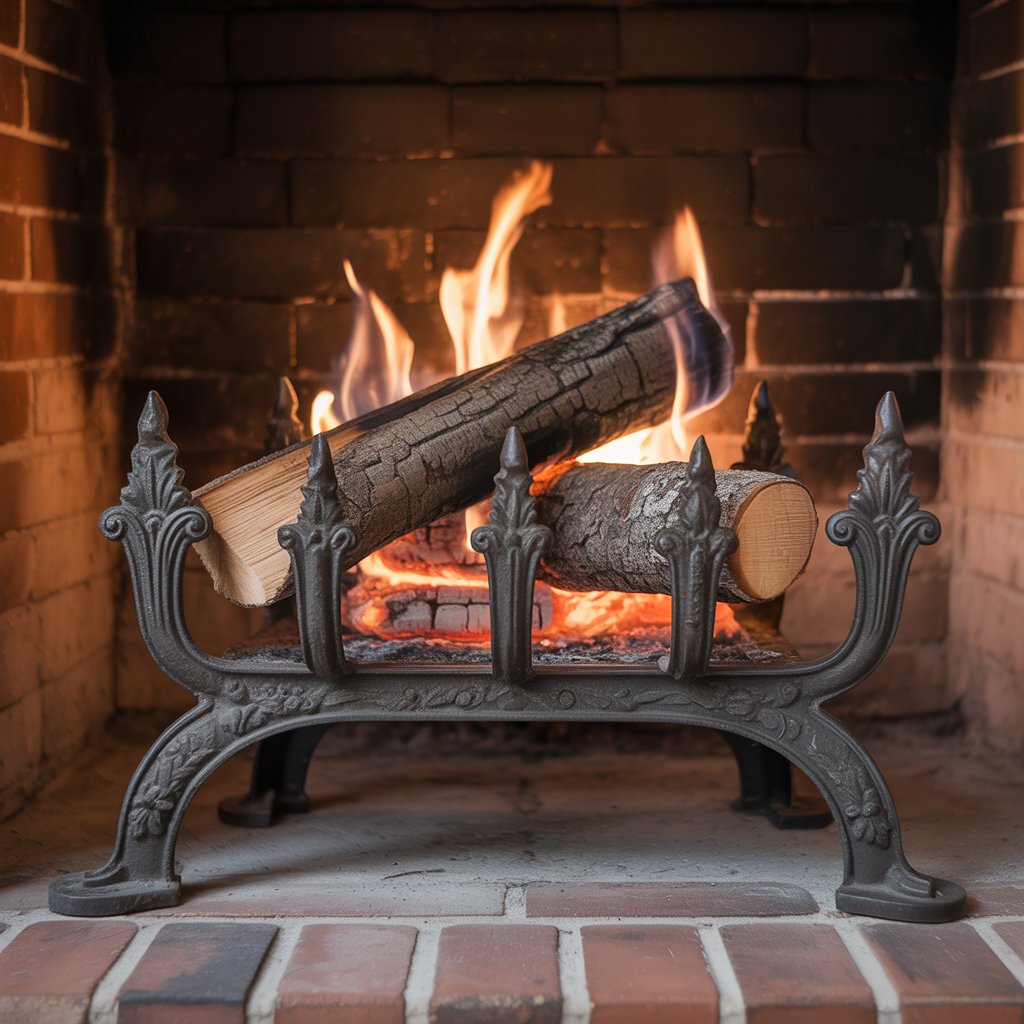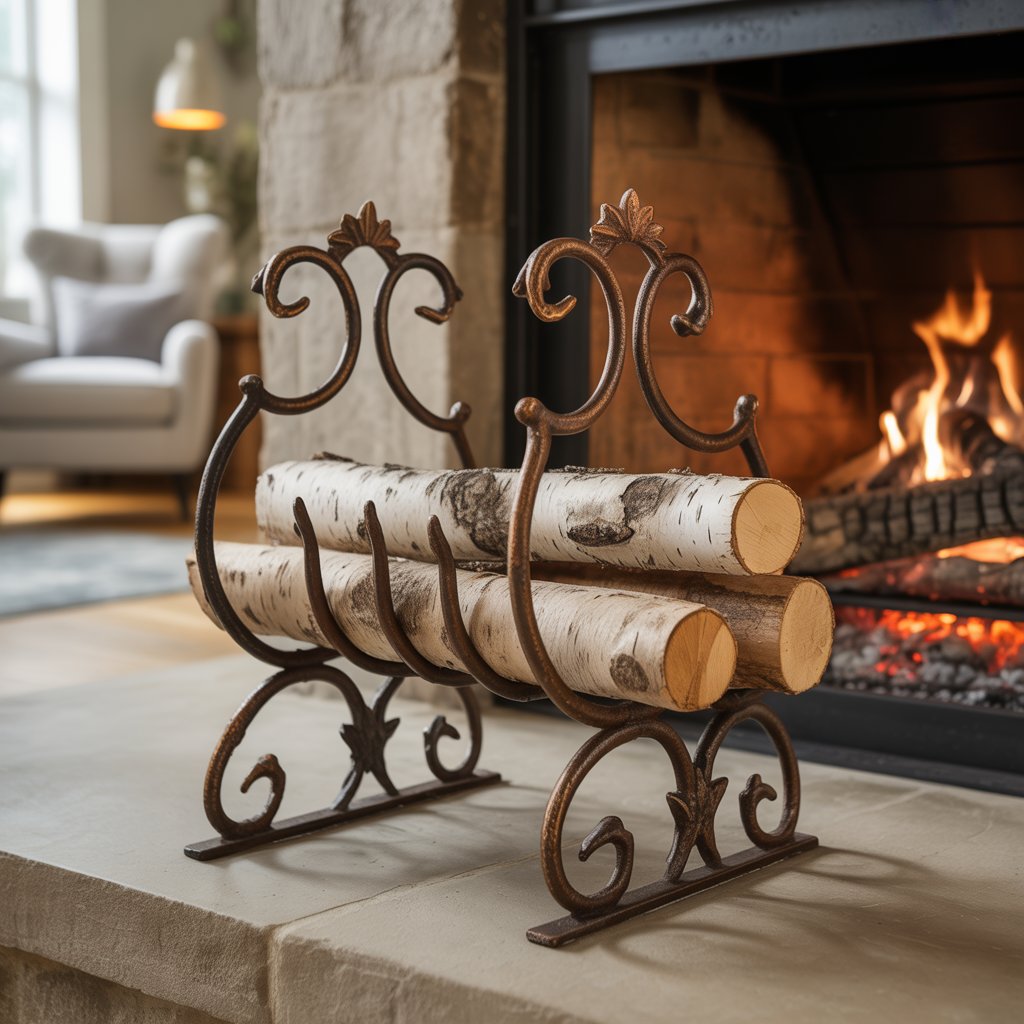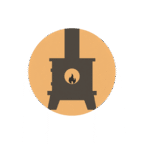Why Fireplace Andirons Matter
I run into the same scenario every fall. Someone invites me over, proud of a freshly swept chimney and a neat stack of seasoned oak. The hearth looks great, the tools gleam, then I peek inside and spot the weak link, a tired grate sagging in the middle, no fireplace andirons in sight. The first fire chokes, smoke curls, and logs slide forward like they’re trying to escape.
A good pair of fireplace andirons fixes all of this. They raise the wood to admit air, keep the fuel from rolling, and protect the hearth floor. They also define the look of your firebox when it’s cold, which, let’s be honest, is most of the time. That’s why I recommend andirons in almost every open fireplace. The right set makes starting, tending, and enjoying fires easier, cleaner, and safer, and it quietly upgrades the room even when there’s no flame.
The History and Evolution of Fireplace Andirons

The use of fireplace andirons dates back to medieval Europe. Early examples were made from wrought iron and were purely functional, ensuring steady airflow and keeping wood off damp stone floors. Wealthy households soon commissioned ornate wrought iron fireplace dogs with decorative animal shapes, heraldic symbols, or brass embellishments.
By the 18th and 19th centuries, traditional fireplace tools like pokers, tongs, and andirons became status symbols. Some families displayed extravagant antique fireplace andirons made of bronze, while more modest homes stuck with plain cast iron andirons. Today, we see both worlds collide: functional modern fireplace andirons with clean lines, and vintage-inspired reproductions that replicate colonial or Victorian aesthetics.
Materials that matter, and how to pick them like a pro
Cast iron andirons

If you burn regularly, cast iron andirons are your dependable workhorses. They handle serious heat, hold a coal bed nicely, and often cost less than brass. Plain black cast iron reads traditional or colonial, which suits brick fireboxes and wood-beam mantels. Many reproduction “colonial ball top” or “urn top” sets are cast, which is fine, the important part is weight and weld quality where the shank meets the upright.
Wrought iron options

Hand-forged wrought iron fireplace dogs have a tactile, hammered surface and a sturdiness you feel as soon as you lift them. If your taste skews farmhouse or mountain rustic, this is your lane. Look for continuous bar stock, tight hammer work, and clean joinery at the feet. Modern wrought sets can be surprisingly minimalist, too, a simple shepherd’s crook or squared post that plays well with black steel screens.
Brass and bronze varieties

Gorgeous, but think honestly about heat exposure. Polished brass and bronze antique fireplace andirons shine in a formal room, yet regular, hot wood fires will discolor bright finishes. Plenty of people buy brass purely for decorative placement in off-season, then swap to working iron for winter. If you love the look and plan frequent fires, pick a patinated finish and accept a little aging as character.
Stainless steel and modern designs

Stainless gives you crisp lines and a contemporary vibe. Many modern fireplace andirons use stainless or powder-coated steel, sometimes paired with glass doors and linear gas burners. Stainless resists rust well, which also makes it smart in seacoast homes or humid climates.
Quick rule of thumb
If you burn three nights a week all winter, pick cast or wrought. If your fires are occasional or mostly decorative, brass, bronze, or stainless open up more style choices.
Sizing that actually works in the firebox you own
I measure in three passes, because returns are a pain and wrong size ruins performance.
- Depth, Measure firebox depth, then measure your typical logs. Your fireplace andirons should support at least two to three inches between shank ends and the back wall. If your logs are 18 inches, a 12 to 14 inch shank works. Leave two to three inches between the ends of the shanks and the back wall for airflow and to protect masonry.
- Width, Center the pair so you have at least three inches of clearance to each sidewall. Too tight and you choke the fire, too wide and the first log sags in the middle.
- Height, Uprights around 6 to 10 inches tall work for most open fireplaces. Tall finials are fine aesthetically, but the working height that matters is the shank height off the floor, typically 2 to 4 inches. That’s where airflow happens.
- Weight capacity, If you burn dense hardwood like oak or hickory and you like big splits, choose heavy duty andirons with stout shanks and triangulated feet. Cheap, thin stock twists over time.
Building inspectors and national codes govern the fireplace, not the andirons themselves, so the onus is on you to pick hardware that fits your box and your fuel. The NFPA 211 standard, which covers chimneys and venting of solid fuel appliances, is the backdrop I follow for clearances and safety context. NFPA For broader fireplace planning, This Old House gives practical sizing and efficiency notes that complement these field tips.
For more Consideration and Tips for Choosing Fireplace Andirons and Grates check Family Handyman.
Installation and positioning that deliver easy starts and safer burns
Here’s the way I place them on day one, and I rarely have to change it.
- Centered, parallel, and roughly a foot to 16 inches apart for 16 to 20 inch logs
- Shanks oriented straight back, not toe-ing in
- A small 2 inch air gap between the shank ends and the back wall
- If you use a grate, set the grate ON the shanks, not behind them, so the grate benefits from the uplift and fence
Airflow is your friend. Fire service and homeowner resources repeatedly call out that raising fuel for air circulation reduces smolder and smoke, which squares with how andirons make lighting easier.
Safety context that never goes out of style
Keep combustibles away, maintain screens, and teach family members to treat even “cool-looking” embers with respect. HPBA’s safety pages are worth bookmarking if you have glass fronts or you run a gas log set, since hot glass is no joke. Codes and standards change over time, but NFPA 211 remains a foundational reference for chimneys and venting.
Maintenance that adds years, not chores
- After every few fires: Knock ash off the shanks, sweep to one side, and check that the andirons are still square to the opening. If you use a grate on top, inspect welds where heat is harshest, the center rails.
- Once a season: For cast iron, a quick rub with stove polish or a thin coat of high-heat oil brings back the black. For brass or bronze, use a non-abrasive polish and a soft cloth, then stop, you can polish metal to death.
- Ash handling: Most fires leave hot cores hours after the last flame, so use a metal ash bucket with a lid and park it outdoors on masonry, not on your deck. Home safety pros and chimney sweeps repeat the same mantra, treat all ashes as live, use metal containers, and keep them away from combustibles, which is the only way I’ve avoided the horror stories. Annual chimney inspection and sweeping remain table stakes, and you will see this in multiple consumer guides each winter.
Cast iron vs Wrought Iron Andirons
| Feature | Cast Iron | Wrought Iron |
|---|---|---|
| Heat Performance | Retains heat longer, aiding in maintaining a lively coal bed. | Less brittle if dropped; retains heat well. |
| Durability | Can crack if abused; lasts decades when sized correctly. | Can bend if undersized; lasts decades when sized correctly. |
| Style | Suits traditional colonial and historic revival looks. | Offers rustic to minimalist aesthetics. |
| Price | Generally more affordable for frequent burners. | Quality sets have climbed in price recently. |
How to choose fireplace andirons, a candid checklist

- Be honest about how often you burn, If fires are your winter routine, choose sturdy fireplace andirons in cast or wrought, keep decoration moderate, and prioritize weight and welds.
- Match style to surround, Brass in a rustic stone cave can feel off, and a minimalist stainless pair in a carved marble Victorian mantle can look lost.
- Size to your fuel, If you buy wood by the face cord and love 18 to 20 inch splits, pick shanks that support them.
- Plan the ecosystem, Andirons, grate, screen, tools, and log holder should look like they belong together.
- Think safety first, Read and follow local code, get your chimney inspected yearly, and keep clearances. NFPA and HPBA publish guidance that homeowners can understand.
Product picks people actually end up happy with
I do not recommend anything I would not put in a working hearth. These are common on Amazon, easy to get, and consistently reviewed well. I group them by use case so readers find themselves quickly.
Everyday wood-burning workhorses
- Panacea 15251 Black Cast Iron Andirons, solid cast build, straightforward look, and enough heft to resist shifting when you rake. These are budget-friendly and reliable for weekly fires.
- Minuteman International Shepherd’s Hook Andirons, forged steel with a classic hook profile, excellent for cabins and stone surrounds. The shanks are stout enough for heavy hardwood.
- Amagabeli Heavy Duty Wrought Iron Andirons, wide stance and thick stock, a good match for people who burn big oak or hickory splits and want equipment that will not say uncle.
Formal rooms and decorative installs
- Pilgrim Home and Hearth Antique Brass Andirons, handsome in a white marble mantle, and they age gracefully if you burn occasionally. Use a screen and expect patina, which is part of the charm.
- Liberty Foundry Cast Iron Urn-Top Andirons, give you that colonial silhouette without hunting antiques, with a blackened finish that hides ash and soot weeks into the season.
Contemporary or mixed-use spaces
- UniFlame Modern Stainless Andirons, square posts, simple geometry, and corrosion resistance for humid environments. Works well with gas log arrangements where the look matters as much as heat.
Using andirons with grates, log sets, and firebacks
People ask whether they should use a grate with fireplace andirons. In traditional setups, the grate sits on the shanks so the andirons do the lifting and fencing while the grate cradles kindling and small splits, which can make starting faster. If you already own a solid grate, set it on top of the shanks and test. If your grate sags or smothers the coals, retire it and use logs directly on the shanks with a narrow kindling cradle formed from two small sticks front to back. Many retail guides describe both approaches, but the “on-top” placement is the trick that simplifies tending.
A cast iron fireback behind the andirons reflects heat and protects the firebrick. If your room feels drafty or you have an outer wall behind the chimney, this small addition can make your fires feel warmer at the sofa.
Safety, the non-negotiables worth repeating
- Inspect and sweep annually, always. Homeowner lists and trade groups say this every year because it prevents the bad nights.
- Keep flammable decor away from the opening, and use a screen. HPBA’s seasonal tips and hot-glass safety pages are clear and practical.
- Know that codes live in the background, including NFPA 211 and your local building code chapters on chimneys and fireplaces. When in doubt, ask your sweep or installer, then follow their lead.
- Store ashes smartly, metal container, lid on, outdoors on concrete or stone. It is boring advice that saves garages.
Troubleshooting, because real fires are messy
- Logs roll forward, Narrow the spacing slightly or choose andirons with taller uprights. Make sure the first log rests firmly on both shanks.
- Smoky starts, Use smaller kindling, open the damper fully, and crack a nearby window for two minutes to establish draft. Consider a fireback to help radiance.
- Grate sag, If you run a grate on top of the shanks and it begins to bow, retire it before it drops coals. Andirons alone are fine with sensible stacking. Family Handyman notes andirons outlast many grates precisely because grate bars take the direct heat.
- Finish discoloration on brass, Accept it or move brass to decorative duty and use iron for heavy burning. Polish lightly, not obsessively.
FAQs about Fireplace Andirons
What size fireplace andirons do I need for my fireplace?
Measure your log length and firebox depth. Aim for shanks about two thirds the length of your typical logs, leaving two to three inches between the shank ends and the back wall for airflow. Keep at least three inches of clearance to each sidewall, and set the pair 12 to 16 inches apart for 16 to 20 inch logs.
Can I use fireplace andirons with a gas fireplace?
Yes, as decoration around a gas log set, provided they do not interfere with burner ports or pilot access. If you have glass fronts or little ones in the house, add a certified barrier screen to prevent burns from hot glass, per HPBA guidance.
How much weight can fireplace andirons typically support?
Quality heavy duty andirons handle a full load of hardwood for an open fireplace, usually dozens of pounds without complaint. Prioritize thick shanks and solid welds at the upright joint, and avoid ultra-light decorative sets for daily wood burning.
What’s the difference between andirons and fireplace grates?
Andirons are metal supports that lift logs off the hearth for better airflow and stability, whereas fireplace grates are a metal rack that holds logs together. Some setups combine both for maximum efficiency and safety.
How do I prevent my cast iron andirons from rusting?
Clean them after each fire with a wire brush, wipe down with a cloth, and apply a thin layer of vegetable oil or high-temp stove polish. Store in a dry environment during off-seasons to extend lifespan.
Quick buyer’s snapshots, for skimmers

- Best fireplace andirons for wood burning, Cast or wrought, heavy stock, modest decoration, sturdy feet, and shanks sized to two thirds of your log length.
- Decorative andirons for gas fireplaces, Brass, bronze, or stainless with a barrier screen if you have kids, mounted with a clear path to controls.
- Vintage fireplace andirons buying guide, Shop depth and height first, then motif. Antique dealers categorize by period and dimension, which helps you avoid gorgeous but ill-fitting pairs.
- Fireplace andirons installation tips, Centered, parallel, 12 to 16 inches apart, two to three inches from the back wall, grate on top if you use one.
- Maintaining fireplace andirons, Sweep ash, seasonal wipe and oil for iron, gentle polish for brass, smart ash handling outside.
- Fireplace andirons safety considerations, Annual sweep and inspection, maintain clearances, screen the opening, and follow code context from NFPA 211. For a more hands-on approach, including guidance on removing creosote buildup, you can refer to our detailed guide on how to clean a wood stove chimney yourself.
Conclusion, the small hardware that makes a big difference
When you get fireplace andirons right, fires start with less smoke, logs stay where they should, and the hearth looks intentional when the flames are out. Whether you favor cast iron andirons for daily use, wrought iron fireplace dogs for rustic character, modern fireplace andirons in stainless for a clean line, or antique fireplace andirons purely as decorative fireplace accessories, the formula is the same, size to your logs and firebox, pick the material that suits how you burn, and stay inside the safety rails set by pros and standards. Your fireplace will thank you in the quiet, steady way a well-built fire always does.








